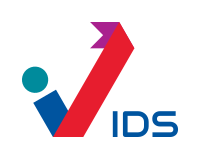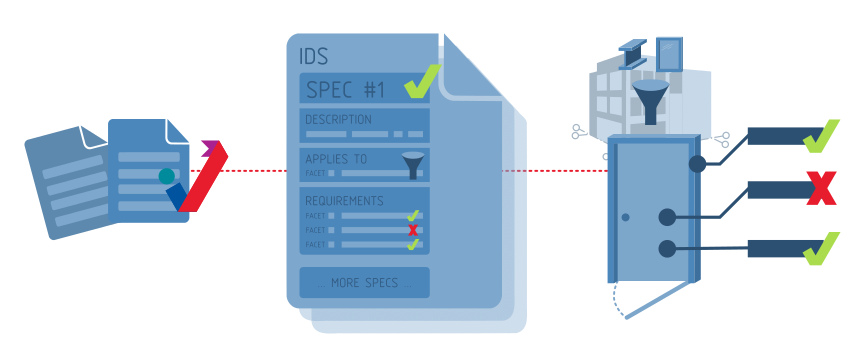Information Delivery Specifications (IDS) is a buildingSMART standard for specifying and checking simple information requirements from IFC models. It is designed as a free, lightweight, standardised approach to model checking.
A buildingSMART IDS file is an XML-based format ending in .ids containing a list of information Specifications. For example, a single Specification might say that "all walls must have a fire rating property". Model authors receiving an IDS file can use it to ensure all required information is provided for each Specification. Model recipients may use the IDS file to check whether the IFC model meets all of the Specifications. Reports may also be generated to list the results of Specification compliance checks.
IDS file creation tools and model checking tools are provided by many software vendors. You can write your own customised IDS Specifications from scratch or start from a public IDS template. Any IFC model produced from any software can be checked by an IDS file.
- Download and install your favourite software that supports IDS from the software vendors directory. There is software available for Windows, Mac, and Linux.
- Download a sample IDS file. This IDS file has two Specifications. The first specifies that the project name should be TEST. The second specifies that all walls must have a fire rating property.
- Download a sample IFC model to check. This IFC model has "TEST" as the project name, which satisfies the first Specification. However, some walls have a fire rating property, and others do not.
- Load both the IDS and the IFC in your software, and begin the checking process.
As a bonus step, try running the IDS with your own IFC models.
A Specification is designed to be easy for humans to understand. However, Specifications are also highly structured so that computer software may automatically and accurately check information requirements with no ambiguity. Every Specification has three parts:
- Description: a description of why the Specification is important to your project and instructions of how to achieve it. This part is designed for humans to read and understand why information is being requested.
- Applicability: which type of objects the Specification applies to. There are many different types of objects in IFC models, such as walls, doors, and windows, but each Specification will only apply to certain objects.
- Requirements: what information is required for the objects specified in part 2, such as required properties or classifications.
For example, the Specification of "all walls must have a fire rating property" is structured like so:
- Description: wall fire ratings are critical for building code compliance
- Applicability: this specification applies to all wall objects
- Requirements: the aforementioned wall objects must have a fire rating property
Applicability and Requirements are described using Facets. A Facet describes information that a single entity (e.g. wall, door, etc) in your model may have. A Facet describes its information precisely using fixed Facet Parameters so that computers can understand exactly what information you are after.
When a Facet is used in the Applicability section, the Facet describes information that an entity needs to have for the Specification to be Applicable to the entity.
When a Facet is used in the Requirements section, the Facet describes information that an entity needs to have to comply with the Specification.
There are six different Facets of information:
| Facet Type | Facet Parameters | Example applicability | Example requirement |
|---|---|---|---|
| Entity | IFC Class and Predefined Type | Applies to "IfcWall" with predefined type of "SHEAR" | Must be an "IfcWall" with a predefined type of "SHEAR" |
| Attribute | Name and Value | Applies to elements with the attribute "Name" having the value "W01" | Must have the attribute "Name" with the value "W01" |
| Classification | System and Value | Applies to elements classified under "Uniclass 2015" as "EF_25_10_25" | Must have a "Uniclass 2015" classification reference of "EF_25_10_25" |
| Property | Property Set, Name, and Value | Applies to elements with a property set of "Pset_WallCommon" with a "LoadBearing" property set to "TRUE" | Must have a "Pset_WallCommon" property set with a "LoadBearing" property set to "TRUE" |
| Material | Value | Applies to "concrete" elements | Must have a "concrete" material |
| Parts | Entity and Relationship | Applies to elements that are "contained in" an "IfcSpace" | Must be "contained in" an "IfcSpace" |
You can combine multiple Facets together in either the Applicability or Requirements section to describe a wide variety of Specifications. Some Facets may have optional Facet Parameters. For example, if you want to specify that a property should exist, but not the exact value, you may omit the value parameter of the Property Facet.
You may also specify a list of valid values, or a range of numbers, or text pattern for some Facet Parameters. These are known as Complex Restrictions. For example, you would use a Complex Restriction to specify that a fire rating property must choose from either the value "0HR", "1HR", or "2HR" only.
Here are a few examples to whet your appetite:
| Description | Applicability | Requirements |
|---|---|---|
| External load bearing walls need to have a fire rating property for code compliance |
|
|
| Bedrooms should have a minimum area of 10m2 |
|
|
| All brick wall types must be classified and follow the approved naming convention |
|
|
To see the full capabilities of what each information each Facet can specify, see the sections below for more detail.
Each Specification may also specify whether it is Required, Optional, or Prohibited. Given the example Specification of "all walls must have a fire rating property" this is the interpretation:
| Type | Meaning | Example |
|---|---|---|
| Required | The specified information must be found in the IFC model | The model must have walls, and they must all have a fire rating property |
| Optional | If there are elements in the IFC model that are applicable to the Specification, then the Requirements must be satisfied | The model may or may not have walls. If they do, then they must have a fire rating property |
| Prohibited | The specified information must not be found in the IFC model | The model should not have any walls that have a fire rating property. Walls without a fire rating property are allowed. Other non-wall elements with a fire rating property are also allowed. |
Each Specification may specify the IFC schema(s) that it applies to. If a model does not match the schema(s), the Specification will not apply and will not be audited. The supported IFC schemas are:
- IFC4X3
- IFC4
- IFC2X3
IDS assumes that the provided IFC model only contains valid data. If the model has syntax errors or IFC schema validation errors, then the model may not be able to be audited. It is the responsibility of the IFC authoring software to ensure that the produced IFCs are valid.
The first version of IDS targets basic information and relationships in IFC that are common to all disciplines. More advanced information requirements are currently out of scope for IDS. For example, geometry checks, checks that rely on calculated or dynamic values, checks that reference data outside the IFC model, or use domain specific IFC relationships are not possible. Here are some types of advanced requirements that you will need other tools to help audit:
- There must be no clashes between structural beams and pipes
- All walls need to be 3m away from the site boundary
- The total area of all office spaces must be more than 300m2
- The names of all door types must be unique
- All pumps need to have a nominated supplier and manufacturer
- All air handling units must have sensors assigned with trigger events
- Saturday and sunday must be a holiday in all work schedules
- All models shall load in under 3 minutes by major software vendors
- Associated drawings in the model must match the latest revisions in the CDE
- All rebar should be modeled as parametric swept disks
- The model must match the as-built state of construction
- See our directory of publicly available IDS templates to get started
- Guidelines on specifying good Specification metadata
- Learn how to specify Complex Restrictions
- Learn how to use the Entity Facet
- Learn how to use the Attribute Facet
- Learn how to use the Classification Facet
- Learn how to use the Property Facet
- Learn how to use the Material Facet
- Learn how to use the Parts Facet
- Still stuck? Ask for help on using IDS
- Are you a software developer? Read the developer guide!


